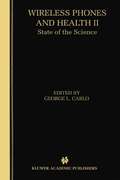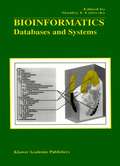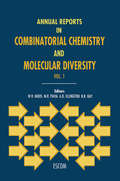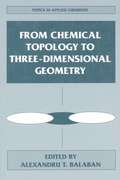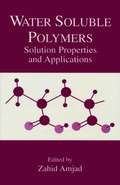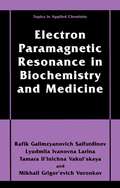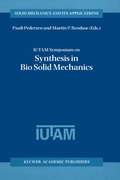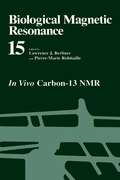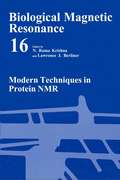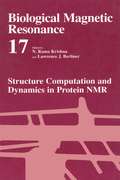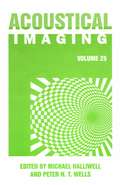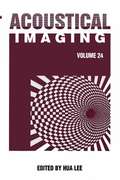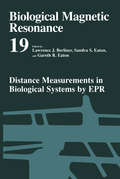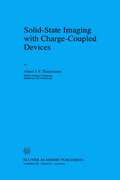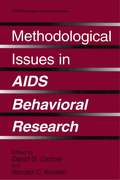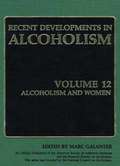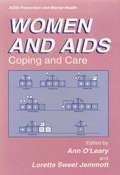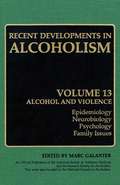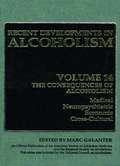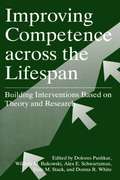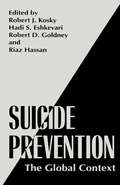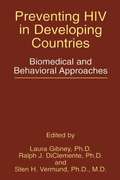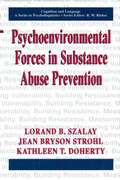- Table View
- List View
Wireless Phones and Health II: State of the Science (Wireless Phones And Health Ser.)
by George L. Carlo Polly M. ThibodeauFrom the time questions about the impact of wireless technology on public health were first raised in 1993 through the present, Wireless Technology Research, LLC (WTR) has been the largest independent surveillance and research program trying to identify and solve human health problems associated with wireless phones. In 1995 at the University “La Sapienza” of Rome, WTR sponsored the first comprehensive forum for the discussion of these issues. Papers from the 1995 State of the Science Colloquium were collected andpublished in Volume I ofthis series, Wireless Phones andHealth: Scientific Progress. This second volume assembles papers presented at WTR’s Second State of the Science Colloquium in Long Beach, CA, in June 1999; it contains the most comprehensive research on the public health impact of wireless phones to date. The operating words for the proper understanding of these data are science and public health. Science is a tool for making public health decisions, but the framework in which we are operating is truly that of public health. We are looking for problems that have to do with wireless technology. We are trying to decide how this technology impacts on the public for one purpose and one purpose alone, and that purpose is to solve problems that are identified. I would like to challenge you, the reader, to suspend your parochial orientation as you consider these latest findings.
Constraints on Language: Aging, Grammar, And Memory
by Susan KemperSusan Kemper A debate about the role of working memory in language processing has become center-most in psycholinguistics (Caplan & Waters, in press; Just & Carpenter, 1992; Just, Carpenter, & Keller, 1996; Waters & Caplan, 1996). This debate concerns which aspects of language processing are vulnerable to working memory limitations, how working memory is best measured, and whether compensatory processes can offset working memory limitations. Age-comparative studies are particularly relevant to this debate for several reasons: difficulties with language and communication are frequently mentioned by older adults and signal the onset of Alzheimer's dementia and other pathologies associated with age; older adults commonly experience working memory limitations that affect their ability to perform everyday activities; the rapid aging of the United States population has forced psychologists and gerontologists to examine the effects of aging on cognition, drawing many investigators to the study of cognitive aging. Older adults constitute ideal population for studying how working memory limitations affect cognitive performance, particularly language and communication. Age-comparative studies of cognitive processes have advanced our understanding of the temporal dynamics of cognition as well as the working memory demands of many types of tasks (Kliegl, Mayr, & Krampe, 1994; Mayr & Kliegl, 1993). The research findings reviewed in this volume have clear implications - for addressing the practical problems of older adults as consumers of leisure ti- reading, radio and television broadcasts, as targets of medical, legal, and financial documents, and as participants in a web of service agencies and volunteer activities.
Bioinformatics: Databases and Systems
by Stanley LetovskyBioinformatics brings computational methods to the analysis and processing of genomic data. Bioinformatics: Databases and Systems focuses on the issues of system building and data curation that dominate the day-to-day concerns of bioinformatics practitioners. Included are chapters by many of today's leading bioinformatics practitioners, describing most of the current paradigms of system building and curation, including both their strengths and weaknesses. Biological topics covered include sequence databases, metabolic pathways, phenotypes, variety collections, gene expression atlases and neuroinformatics. Species range from bacteria to mammals to plants. Software systems and technologies covered include OPM, CORBA, SRS, KLEISLI, ACEDB, Web-based integration and laboratory workflow. Bioinformatics: Databases and Systems provides a valuable introduction for newcomers to the field, and a useful reference for veterans.
Annual Reports in Combinatorial Chemistry and Molecular Diversity (Annual Reports in Combinatorial Chemistry & Molecular Diversity #1)
by W.H. Moos, M.R. Pavia, B.K. Kay and A.D. EllingtonCombinatorial chemistry and molecular diversity approaches to scientific inquiry and novel product R&D have exploded in the 1990s! For example, in the preparation of drug candidates, the automated, permutational, and combinatorial use of chemical building blocks now allows the generation and screening of unprecedented numbers of compounds. Drug discovery - better, faster, cheaper? Indeed, more compounds have been made and screened in the 1990s than in the last hundred years of pharmaceutical research. This first volume covers: (i) combinatorial chemistry, (ii) combinatorial biology and evolution, and (iii) informatics and related topics. Within each section chapters are prepared by experts in the field, including, for example, in Section I: Coverage of mixture pools vs. parallel individual compound synthesis, solution vs. solid-phase synthesis, analytical tools, and automation. Section II highlights selection strategies and library-based evolution, phage display, peptide and nucleic acid libraries. Section III covers databases and library design, high through-put screening, coding strategies vs. deconvolutions, intellectual property issues, deals and collaborations, and successes to date.
From Chemical Topology to Three-Dimensional Geometry (Topics in Applied Chemistry)
by Alexandru T. BalabanEven high-speed supercomputers cannot easily convert traditional two-dimensional databases from chemical topology into the three-dimensional ones demanded by today's chemists, particularly those working in drug design. This fascinating volume resolves this problem by positing mathematical and topological models which greatly expand the capabilities of chemical graph theory. The authors examine QSAR and molecular similarity studies, the relationship between the sequence of amino acids and the less familiar secondary and tertiary protein structures, and new topological methods.
Water Soluble Polymers: Solution Properties and Applications
by Zahid AmjadThis volume contains a series of papers originally presented at the symposium on Water Soluble Polymers: Solution Properties and Applications, sponsored by the Division of Colloids and Surface Chemistry of the American Chemical Society. The symposium took place in Las Vegas City, Nevada on 9 to 11th September, 1997 at the 214th American Chemical Society National Meeting. Recognized experts in their - spective fields were invited to speak. There was a strong attendance from academia, g- ernment, and industrial research centers. The purpose of the symposium was to present and discuss recent developments in the solution properties of water soluble polymers and their applications in aqueous systems. Water soluble polymers find applications in a number of fields of which the following may be worth mentioning: cosmetics, detergent, oral care, industrial water treatment, g- thermal, wastewater treatment, water purification and reuse, pulp and paper production, sugar refining, and many more. Moreover, water soluble polymers play vital role in the oil industry, especially in enhanced oil recovery. Water soluble polymers are also used in ag- culture and controlled release pharmaceutical applications. Therefore, a fundamental kno- edge of solution properties of these polymers is essential for most industrial scientists. An understanding of the basic phenomena involved in the application of these polymers, such as adsorption and interaction with different substrates (i. e. , tooth enamel, hair, reverse - mosis membrane, heat exchanger surfaces, etc. ) is of vital importance in developing high performance formulations for achieving optimum efficiency of the system.
Electron Paramagnetic Resonance in Biochemistry and Medicine (Topics in Applied Chemistry)
by Rafik Galimzyanovich Sajfutdinov Lyudmila Ivanovna Larina Tamara Il'inichna Vakul'skaya Mikhail Grigor'evich VoronkovElectron Paramagnetic Resonance (EPR) spectroscopy - also sometimes termed Electron Spin Resonance spectroscopy - has manifold potential uses in biochemistry and medicine. The paramount importance of EPR spectroscopy applied to biological tissues and fluids is that it identifies the changes in redox processes that contribute to disease. EPR spectroscopy has come a long way from its original use to detect malignant tumors. For example, the development and later refinement of methods of low-temperature registration of biological tissues widened the scope of EPR spectroscopy. Innovations made possible by the introduction of spin labels, probes, and traps made EPR spectroscopy ever more applicable to biochemistry and medicine, to the point where in vivo studies are being carefully considered. This comprehensive book discusses spectra of many tissues and bodily fluids, and the quantitative nature of paramagnetic centers in both normal individuals and patients suffering from a variety of diseases. Special attention is given to the EPR examination of bio-molecules, such as enzymes, polypeptides, vitamins, lipids, hydrocarbons, etc., which play an essential role in human activity. This book will be of great interest to physicians specializing in many different areas. Similarly, biologists, biochemists, biophysicists, and chemists will find this book very useful. It has also been written so that it may be used as a textbook at graduate level.
IUTAM Symposium on Synthesis in Bio Solid Mechanics: Proceedings of the IUTAM Symposium held in Copenhagen, Denmark, 24–27 May 1998 (Solid Mechanics and Its Applications #69)
by Pauli Pedersen Martin P. BendsøeThis book contains the edited version of invited lectures presented at the IUTAM-Sym- sium Synthesis in Bio Solid Mechanics, held at Hotel Frederiksdal, Virum (Copenhagen), Denmark, May 24 to May 27, 1998. The symposium was attended by 48 scientist from 14 countries. Biomechanics has been a very active research area in the last 25 years and covers a very broad class of problems. The present symposium concentrated on the solid mechanics - main of biomechanics, where important problems of synthesis presently are an active and challenging part. Characteristics of biomechanical materials are not only the inhomogeneity and anisotropy, but also the capability to change in relation to actual use. These living materials call for new methods of analysis and also new methods for synthesis. By the synthesis in this context is meant design of implants or artificial control of material growth. Bone mechanics is closely related to recent work on analysis and design of microstructural anisotropic materials. Also, recent work in shape design can to some extent be useful in the more complicated problems of biomechanics. Here interface problems play an essential role. The symposium brought together scientists from mechanics, mathematics and medicine.
Biological Magnetic Resonance: In Vivo Carbon-13 NMR (Biological Magnetic Resonance #15)
by Lawrence J. Berliner Pierre-Marie RobitailleThis volume constitutes a compilation of the latest experiments and theories on a rapidly evolving and maturing field in MRI/MRS, which is the use of the stable isotope 13-C. The 13-C is used to probe the chemistry, mechanism, and function in living systems. All the chapters are written by experts in the field who discuss topics such as `Tracer Theory and the Suitability of 13-C NMR', `Applications of 13-C to Studies of Human Brain Metabolism', etc.
Modern Techniques in Protein NMR (Biological Magnetic Resonance #16)
by N. Rama Krishna Lawrence J. BerlinerVolume 16 marks the beginning of a special topic series devoted to modern techniques in protein NMR, under the Biological Magnetic Resonance series. This volume is being followed by Volume 17 with the subtitle Structure Computation and Dynamics in Protein NMR. Volumes 16 and 17 present some of the recent, significant advances in biomolecular NMR field with emphasis on developments during the last five years. We are honored to have brought together in these volumes some of the world’s foremost experts who have provided broad leadership in advancing this field. Volume 16 contains advances in two broad categories: the first, Large Proteins, Complexes, and Membrane Proteins, and second, Pulse Methods. Volume 17, which will follow covers major advances in Computational Methods, and Structure and Dynamics. In the opening chapter of Volume 16, Marius Clore and Angela Gronenborn give a brief review of NMR strategies including the use of long range restraints in the structure determination of large proteins and protein complexes. In the next two chapters, Lewis Kay and Ron Venters and their collaborators describe state-of-t- art advances in the study of perdeuterated large proteins. They are followed by Stanley Opella and co-workers who present recent developments in the study of membrane proteins. (A related topic dealing with magnetic field induced residual dipolar couplings in proteins will appear in the section on Structure and Dynamics in Volume 17).
Structure Computation and Dynamics in Protein NMR (Biological Magnetic Resonance #17)
by N. Rama Krishna Lawrence J. BerlinerVolume 17 is the second in a special topic series devoted to modern techniques in protein NMR, under the Biological Magnetic Resonance series. Volume 16, with the subtitle Modern Techniques in Protein NMR , is the first in this series. These two volumes present some of the recent, significant advances in the biomolecular NMR field with emphasis on developments during the last five years. We are honored to have brought together in these volume some of the world s foremost experts who have provided broad leadership in advancing this field. Volume 16 contains - vances in two broad categories: I. Large Proteins, Complexes, and Membrane Proteins and II. Pulse Methods. Volume 17 contains major advances in: I. Com- tational Methods and II. Structure and Dynamics. The opening chapter of volume 17 starts with a consideration of some important aspects of modeling from spectroscopic and diffraction data by Wilfred van Gunsteren and his colleagues. The next two chapters deal with combined automated assignments and protein structure determination, an area of intense research in many laboratories since the traditional manual methods are often inadequate or laborious in handling large volumes of NMR data on large proteins. First, Werner Braun and his associates describe their experience with the NOAH/DIAMOD protocol developed in their laboratory.
Acoustical Imaging
by Michael Halliwell Peter N. T. WellsThe origin ofthe International Acoustical Imaging Symposium series can be traced to 1967, when a meeting on acoustical holography was held in C alifornia. In those days, acoustical holography was at the leading edge of research but, as the importance of this subject waned, so the title of the series was changed from Acoustical Holography to Acoustical Imaging in 1978. The early Symposia were held at various venues in the United States. In 1980. the series became international, with the Symposium that year taking place in Cannes in France. The pattern now is to try to met alternately in the USA and in another part of the world so that active researchers everywhere can conveniently attend at a reasonably high frequency. It was a great privilege for us in Bristol in the United Kingdom to be chosen to host the 25th Symposium, which convened on 19 March 2000 and spread over four days. We were blessed not only by good weather, but also by the attendance ofnearly 100 pa rticipants who came from 17 c ountries. A large number of papers were accepted for presentation, either orally or as posters. Whether an oral presentation or a poster, all were considered to have equal merit, and no distinction is made between them in the published proceedings. There were no parallel sessions, so every participant could attend every presentation. The re sultant disciplinary cross fertilisation maintained the t radition of past Symposia.
Acoustical Imaging (Acoustical Imaging #24)
by Hua Hua LeeThe International Symposium of Acoustical Imaging has been widely recognized as the premier forum for presentations of advanced research results in both theoretical and experimental development. Held regularly since 1968, the symposium brings together th leading international researchers in the area of acoustical imaging. The 24 meeting is the third time Santa Barbara hosted this international conference and it is the first time the meeting was held on the campus of the University of California, Santa Barbara. As many regular participants noticed over the years, this symposium has grown significantly in size due to the quality of the presentations as well as the organization itself. A few years ago multiple and poster sessions were introduced in order to accommodate this growth. In addition, the length of the presentations was shortened so more papers could be included in the sessions. During recent meetings there were discussions regarding the possibility of returning to the wonderful years when the symposium was organized in one single session with sufficient time to allow for in-depth presentation as well as discussions of each paper. And the size of the meeting was small enough that people were able to engage in serious technical interactions and all attendees would fit into one photograph. In light of the constraints of the limited budget with respect to the escalating costs it was not considered feasible.
Distance Measurements in Biological Systems by EPR (Biological Magnetic Resonance #19)
by Lawrence J. Berliner Gareth R. Eaton Sandra S. EatonDistance measurements in biological systems by EPR The foundation for understanding function and dynamics of biological systems is knowledge of their structure. Many experimental methodologies are used for determination of structure, each with special utility. Volumes in this series on Biological Magnetic Resonance emphasize the methods that involve magnetic resonance. This volume seeks to provide a critical evaluation of EPR methods for determining the distances between two unpaired electrons. The editors invited the authors to make this a very practical book, with specific numerical examples of how experimental data is worked up to produce a distance estimate, and realistic assessments of uncertainties and of the range of applicability, along with examples of the power of the technique to answer biological problems. The first chapter is an overview, by two of the editors, of EPR methods to determine distances, with a focus on the range of applicability. The next chapter, also by the Batons, reviews what is known about electron spin relaxation times that are needed in estimating distances between spins or in selecting appropriate temperatures for particular experiments. Albert Beth and Eric Hustedt describe the information about spin-spin interaction that one can obtain by simulating CW EPR line shapes of nitroxyl radicals. The information in fluid solution CW EPR spectra of dual-spin labeled proteins is illustrated by Hassane Mchaourab and Eduardo Perozo.
Solid-State Imaging with Charge-Coupled Devices (Solid-State Science and Technology Library #1)
by A.J. TheuwissenSolid-State Imaging with Charge-Coupled Devices covers the complete imaging chain: from the CCD's fundamentals to the applications. The book is divided into four main parts: the first deals with the basics of the charge-coupled devices in general. The second explains the imaging concepts in close relation to the classical television application. Part three goes into detail on new developments in the solid-state imaging world (light sensitivity, noise, device architectures), and part four rounds off the discussion with a variety of applications and the imager technology. The book is a reference work intended for all who deal with one or more aspects of solid- state imaging: the educational, scientific and industrial world. Graduates, undergraduates, engineers and technicians interested in the physics of solid-state imagers will find the answers to their imaging questions. Since each chapter concludes with a short section `Worth Memorizing', reading this short summary allows readers to continue their reading without missing the main message from the previous section.
Methodological Issues in AIDS Behavioral Research (Aids Prevention and Mental Health)
by David G. Ostrow Ronald C. KesslerMethodological problems have hampered researchers' efforts to understand and control AIDS since the beginning of the epidemic. This practical book addresses these problems by using actual health research case studies to develop strategies regarding design and sampling, measurement, and analysis and modeling issues. Researchers working on both biological and behavioral aspects of the disease will find this work a singularly effective tool to improve their study designs.
Alcoholism and Women (Recent Developments in Alcoholism #12)
by HelenEdwards DavidThiel MarcusRothschild AlfonsoParedes EdwardGottheil DonaldGoodwin DonaldGallant RichardDeitrich HenriBegleiter MarcGalanter'Solid, plausible, accurate and loaded with pertinent and highly referenced information regarding clinical and basic research in alcholism among women and ethnic groups...an essential text in the libraries of academicians, teachers, clinicians, researchers, and policy makers. The quality and scope of the work are groundbreaking, and it is convenient to have it all in one source.' -American Journal of Psychiatry Volume 12 highlights the remarkable evolution of alcoholism research during the last few years, focusing on gender in alcohol actions and consequences.
Women and AIDS: Coping and Care (Aids Prevention and Mental Health)
by Ann O’Leary Loretta Sweet Jemmott R. N.Although women were understudied in the early years of the epidemic, research and practice devoted to understanding and ameliorating the effects of the AIDS epidemic have begun in recent years. Women and AIDS is the first comprehensive exploration of the medical and psychosocial concerns and issues surrounding women living with HIV/AIDS. Contributors address the biomedical aspects of the disease, stress and coping factors, reproductive and childcare issues, access to care, needs of special populations such as drug-using women and adolescents, and policy recommendations. Researchers and students in psychology, public health, medicine, nursing, sociology, women's studies, and social work will appreciate this reference.
Recent Developments in Alcoholism: Alcohol and Violence - Epidemiology, Neurobiology, Psychology, Family Issues (Recent Developments in Alcoholism #13)
by Henri Begleiter Deirdre Winczewski Richard Deitrich Richard Fuller Donald Gallant Donald W. Goodwin Edward Gottheil Alfonso Paredes Marcus Rothschild David H. van ThielFrom the President of the Research Society on Alcoholism On behalf of the Research Society on Alcoholism, I am pleased to introduce this thirteenth volume of Recent Developments in Alcoholism about alcohol and violence. Current concepts are presented in well-organized sections that - cus on epidemiology, neurobiology, psychology, and family issues. It is - coming increasingly clear that age, gender, socioeconomic circumstances, and genetics affect aggressive behavior and vulnerability to alcoholism. This v- ume contains up-to-date discussions of these issues. Indeed, the information presented here will help all alcohol researchers to identify biological and social factors that contribute to the comorbidity of alcoholism and aggression. The editors and associate editors should be congratulated for bringing toge- er such important information. This volume will be a valuable resource for investigators and therapists alike. Ivan Diamond M. D. , Ph. D. President, Research Society on Alcoholism From the President of the American Society of Addiction Medicine The American Society of Addiction Medicine is honored to continue its - sponsorship with the Research Society on Alcoholism of Recent Developmen ts in Alcoholism. The topic of alcohol and violence is a particularly timely one, given the growing number of studies that are examining the relationship between the two. These studies are consistent with the hypothesis that al- hol can increase aggression and contribute to both domestic and criminal violence. Intoxicating blood levels of alcohol have been found to be especially prevalent in those injured in fights and assaults.
Sociolegal Control of Homosexuality: A Multi-Nation Comparison (Perspectives in Sexuality)
by Donald J. WestDespite the gains made by gay rights movements throughout the world, there are still areas in which homosexuals and their relationships are targeted as immoral and criminal. Sociolegal Control of Homosexuality, a comprehensive, up-to-date examination of governmental and religious reaction to issues of sexual orientation in regions - such as Asia and the Middle East - not often covered in English language publications, includes: a sampling of international legislation, both proscriptive and liberal the effects of fundamentalist religious movements new scientific information concerning the origin of sexual orientation, and much more! £/LIST£
The Consequences of Alcoholism: Medical, Neuropsychiatric, Economic, Cross-Cultural (Recent Developments in Alcoholism #14)
by Marc GalanterFrom the President of the Research Society on Alcoholism On behalf of the Research Society on Alcoholism, I am pleased to introduce this 14th volume of Recent Developments in Alcoholism about the consequences of alcoholism. Current concepts are presented in well-organized sections that focus on the medical, neuropsychiatric, economic, and biobehavioral con- quences of alcoholism. This volume contains up-to-date discussions of these issues. The editors and associate editors should be congratulated for bringing together such important information. This volume will be a valuable resource for investigators and therapists alike. Ivan Diamond M.D., Ph.D. President, Research Society on Alcoholism From the President of the American Society of Addiction Medicine On behalf of the American Society of Addiction Medicine, I am pleased to announce that our society once again will cosponsor Recent Developments in Alcoholism. This volume addresses the issues of age, gender, socioeconomy, and behaviors as they relate to alcohol research and the disease of alcoholism. The medical consequences of alcoholism are ably edited by Dr. Charles L- ber, while the neuropsychiatric consequences of alcoholism are addressed by Drs. Gottheil. This volume is rounded out with the in-depth discussion of the economic consequences of alcoholism, edited by Dr. Fuller, and an inter- tional perspective on the behavioral consequences of alcoholism, edited by Dr. Paredes.
Improving Competence Across the Lifespan: Building Interventions Based on Theory and Research
by Donna R. White Dale M. Stack Alex E. Schwartzman William M. Bukowski DoloresPushkarThis book arises from a conference held in November 1996 designed to examine how competence can be improved in the different stages ofthe lifespan. To this end, we brought together eminent researchers in different areas of human development—infancy, childhood, and adulthood, including the late adult years. The conference was based on the premise that discussion arising from the interfaces of research and practice would increase our knowledge of and stimulate the further application of effective interventions designed to improve competence. The editors wish to acknowledge the contributions of Concordia University and the Fonds pour la Formation de Chercheurs et l’Aide a la Recherche (FCAR) in providing funding and other assistance toward the conference “Improving Competence Across the Lifespan” and toward the publication of this book. Finally, we wish to express our gratitude to the numerous students associated with our Centre for their help and to Gail Pitts and Lesley Husband of the Centre for Research in Human Development for their assistance. We are especially grateful to Donna Craven, Centre for Research in Human Development, for her heroic work on both the conference and the present volume. We could not have met our goals without you.
Suicide Prevention: The Global Context
by Robert J. Kosky Hadi S. Eshkevari Robert D. Goldney Riaz HassanProceedings of the XIXth Congress of the International Association for Suicide Prevention held in Adelaide, Australia, March 23-27, 1997
Preventing HIV in Developing Countries: Biomedical and Behavioral Approaches (Aids Prevention and Mental Health)
by Sten H. Vermund Ralph J. Clemente LauraGibneyGlobally, action to prevent HIV spread is inadequate. Over 16,000 new infections occur every day. Yet we are not helpless in the face of disaster, as shown by the rich prevention experience analyzed in this valuable new compendium. “Best pr- tice” exists—a set of tried and tested ways of slowing the spread of HIV, of persuading and enabling people to protect themselves and others from the virus. Individually, features of best practice can be found almost everywhere. The tragedy, on a world scale, is that prevention is spotty, not comprehensive; the measures are not being applied on anywhere near the scale needed, or with the right focus or synergy. The national response may concentrate solely on sex workers, for example. Elsewhere, efforts may go into school education for the young, but ignore the risks and vulnerability of men who have sex with men. Action may be patchy geographically. AIDS prevention may not benefit from adequate commitment from all parts and sectors of society, compromising the sustainability of the response. In some countries matters are still worse—there is still hardly any action at all against AIDS and scarcely any effort to make HIV visible. It is no wonder that the epidemic is still emerging and in some places is altogether out of control.
Psychoenvironmental Forces in Substance Abuse Prevention (Cognition and Language: A Series in Psycholinguistics)
by Lorand B. Szalay Jean Bryson Strohl Kathleen T. DohertyPsychological vulnerabilities and environment influences are the most powerful forces shaping the behavior and choices of students to use harmful substances. This book employs computer-assisted Associative Group Analysis technology of comparative imaging and cognitive mapping to identify these factors and offers new perspectives for more comprehensive risk assessments and effective prevention.
